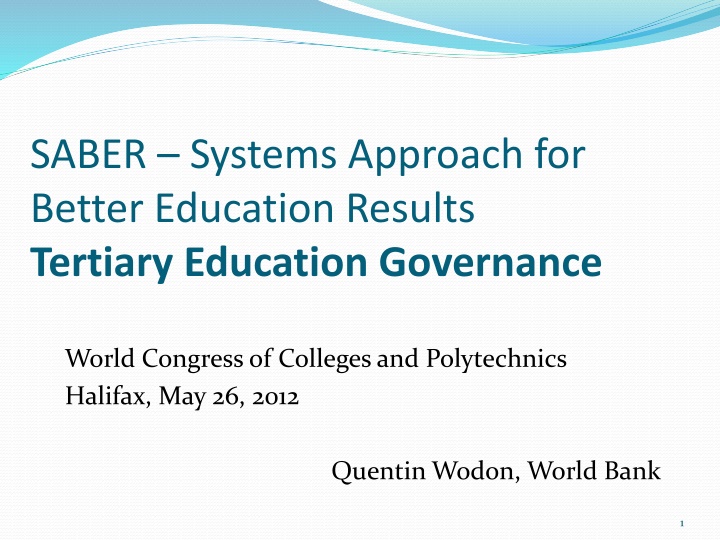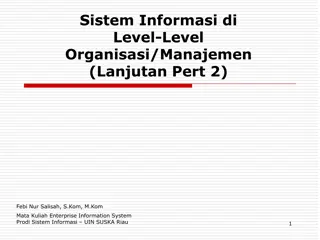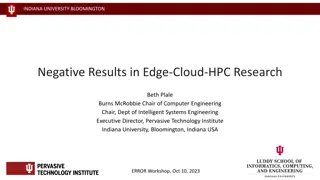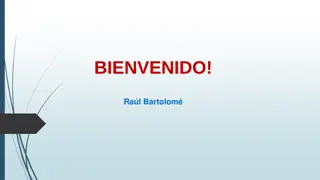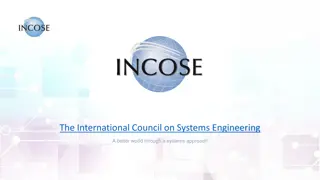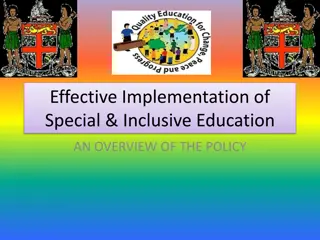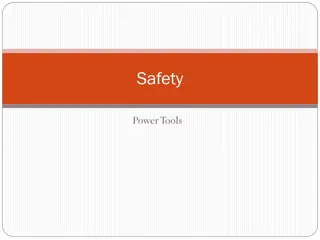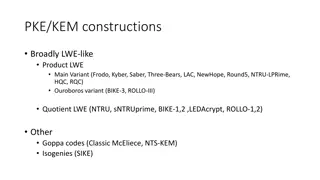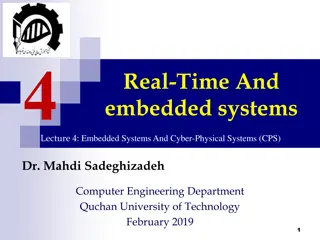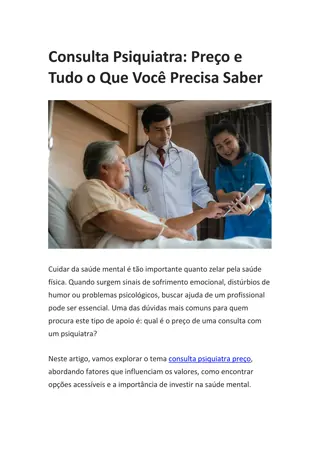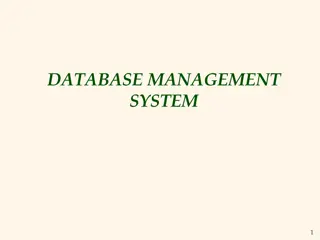SABER Systems Approach for Better Education Results
The SABER Systems Approach for Better Education Results focuses on tertiary education governance, providing a structured presentation on goals, scope, methodology, and data collection. It aims to advance learning through a detailed database of education policies and institutions, empowering stakeholders with open data tools. SABER informs policy choices and implementation gaps, offering tools for assessing policy frameworks and execution.
Download Presentation

Please find below an Image/Link to download the presentation.
The content on the website is provided AS IS for your information and personal use only. It may not be sold, licensed, or shared on other websites without obtaining consent from the author.If you encounter any issues during the download, it is possible that the publisher has removed the file from their server.
You are allowed to download the files provided on this website for personal or commercial use, subject to the condition that they are used lawfully. All files are the property of their respective owners.
The content on the website is provided AS IS for your information and personal use only. It may not be sold, licensed, or shared on other websites without obtaining consent from the author.
E N D
Presentation Transcript
SABER Systems Approach for Better Education Results Tertiary Education Governance World Congress of Colleges and Polytechnics Halifax, May 26, 2012 Quentin Wodon, World Bank 1
Structure of presentation SABER goals, scope, and methodology Context for tertiary education governance System-wide and institution-level indicators Example of data collection for institutions: MENA Analysis of MENA data on autonomy Financial autonomy HR autonomy Academic autonomy Conclusion 2
What SABER is New initiative to advance Learning for All First detailed, disaggregated database of education policies/institutions in core areas Open data tool for empowering stakeholders Two key areas: Maps out policies/institutions Links to implementation data 3
Goal: Make visible whats underwater Inputs and (some) outcomes Everything else: Policies Institutions Implementation Effects of interventions 4
Domain development: Key steps What Matters paper Indicators and scoring rubric Data-collection instrument Data collection Analysis Data validation Publication of data & analyses 5
What SABER provides (not just ratings) Analytical framework for thinking about domain Descriptive data on policies/institutions Evaluative judgments (ratings, not rankings) Latent (poor performance) Emerging (insufficient performance) Established (adequate performance) Advanced (outstanding performance) 6
SABER informs policy choices & diagnoses gaps in implementation in each domain + POLICIES IMPLEMENTATION OUTCOMES Catalog & assess quality of policy framework Collect & analyze data on policy execution Tools to assess implementation based on available data SABER Toolkit Tools to benchmark policies Framework Survey data(e.g. PETS, QSDS, Absence, Household) Proxy indicators (e.g. economy-wide metrics, survey data from other countries) Collection instrument Rubric Manual Country, regional, and policy domain reports with interpretation, including expert judgment Online knowledge base 7
Tertiary education governance Large variation in performance of higher education institutions governance as a key determinant Differences in objectives: research, teaching, contribution to local economy, etc. Not one best model Benchmarking as step towards monitoring performance Three levels of analysis Institutions level: Identification of Strengths and weaknesses, base line for comparison overtime Country level: Identification of models, differences between institutions, correlation between models and performance International level: Comparisons between models, correlations between models and performance 8
System Level Context, Mission and Goals Management Autonomy Accountability Participation Government- driven Government- defined missions and policies Government- appointed president Centrally managed budget Central control for new programs and curriculum Central HR management Central audits Central QA National driven curriculum Low accountability-no links between performance and rewards Mainly on consultation basis Autonomous - Government- steered Mission-oriented Institutions Strategic plans prepared by Institutions Governing boards led Competitive funds allocation Autonomy to introduce new programs and set curriculum HR autonomy External audits Independent external QA Performance-based salaries High participation of stakeholders throughout the decision- making process 9
Context, Mission and Goals Management Orientation Autonomy Accountability Participation High autonomy in all three areas, academic, financial and HR High accountability in financial and HR Mission-oriented Decentralized Corporate Results-based Mission-oriented- Defined in consultation with academic staff High internal academic accountability High participation of academic staff High academic autonomy Academic High participation of stakeholders High external accountability Representational Mission-oriented- Defined in consultation with trustee High internal accountability Trustee Results-based 10
System-wide Policy Goals Goal #1: Vision The country or government has a vision and plan for the tertiary education sector, a willingness to translate its vision into a concrete action plan, and an ability to implement and monitor reforms Goal #2: Regulatory Framework The tertiary education system is governed by an appropriate regulatory framework including for private providers Goal #3: Leadership The TEA has an appropriate policy on the role and functions of the boards of tertiary education institutions, as well as for the selection of the leadership of tertiary education institutions, and the respective responsibilities of the Board and leadership Goal #4: Financial Autonomy and Equity The regulatory framework provides enough financial autonomy to tertiary education institutions while still promoting equity 11
System-wide Policy Goals Goal #5: Staffing Autonomy The regulatory framework provides enough staffing autonomy to tertiary education institutions Goal #6: Academic Autonomy The regulatory framework provides enough academic autonomy to tertiary education institutions Goal #7: Performance-based Funding The TEA negotiates performance targets and uses financing as incentives for institutions to achieve the targets. Goals #8: Quality assurance and transparency The TEA has an independent quality assurance and accreditation agency for both public and private institutions. Institutions are held to specific standards of transparency around financial health, fraud, student engagement and employment of graduates. 12
A Note on QA and quasi-corruption Respons e 95.7% 44.1% 1.2M 0.4M Question Share of household with positive value for annual official school cost Share of household with positive value for annual unofficial school cost Annual official school cost Annual unofficial school cost Did you or anyone in your family make unofficial payments to get admission? Yes No It is common for parents to make some unofficial payments to gain admission? Never Seldom Sometimes Frequently Always When unofficial payments are required, how is it done? A school official indicates or asks for a payment The parent or family member offer a payment on his/her own accord It is known before hand how to pay and how much to pay, so it is not discussed 27.2% 72.8% 1.1% 2.2% 43.0% 47.3% 6.5% 30.3% 37.1% 32.6% 13
Institution-level: MENA University Governance Screening Card Tool to assess to what extent Universities are following good Governance practices aligned with their Institutional Goals, but also to allow Universities monitor their progress and compare themselves with other institutions Inspiration: Guidelines and Good Practice Codes that have been revised by OECD Autonomy Score Card- European University Association CUC in the UK Benchmarking guidelines- Australian Universities West Coast Guidelines, USA 14
Institution-level screening card DIMENSION 1: CONTEXT, MISSION and GOALS Are the missions of the University formally stated? DIMENSION 2: MANAGEMENT Are the management mechanisms results-based or traditional? DIMENSION 3: AUTONOMY What is the degree of academic, HR Management, and financial autonomy? DIMENSION 4: ACCOUNTABILITY AND PARTICIPATION How much is the university held responsible vis vis its stakeholders? Do the stakeholders have a voice in decision making? 15
Example of Autonomy - Financial Financial autonomy - ability of universities to: set tuition fees accumulate reserves keep surplus on state funding borrow money invest money in financial or physical assets own and sell the land and buildings they occupy deliver contractual services; attract funds on a competitive basis. 16
Example of Autonomy - Academic Academic autonomy Responsibility for curriculum design Extent to which universities are autonomous to introduce or cancel degree programs and to determine academic structure Overall number of students Admissions criteria Admissions per discipline; Evaluation of programs; Evaluation of learning outcomes Teaching methodologies. 17
Example of Autonomy HR Human Resources autonomy Recruitment procedures for appointment of academic and other staff hiring and firing Status of employees (whether they are considered civil servants or not) Procedure for determining salary levels, salary incentives, and workloads Human resources policies Career development policies Performance management. 18
MENA Case study: Sample size Egypt: 12 universities Morocco: 9 universities Palestine: 9 universities Tunisia: 10 universities 6 Public 8 Public 2 Public 7 Public 6 Private 1 Private 7 Private 3 Private Statistical Analysis MCA forconstruction of indices of autonomy Comparisons between countries/types of universities Assessment of correlation structure & causality 19
MENA Case study: MCA results Coord. Categories % Financial Autonomy Has autonomy to define revenue structure of the University (No) 0.08 1.994 Has autonomy to set the level of fees (No) 0.074 1.724 Has autonomy to set the level of fees (Yes) 0.074 -1.724 Has the autonomy to run a deficit (No) 0.07 1.678 Has the autonomy to run a deficit (Yes) 0.07 -1.678 Has autonomy to set bonuses to be paid to private owners (Yes) 0.063 -1.969 Allowed to own Financial Assets (No) Allowed to own Land (No) 0.056 0.055 1.928 2.497 Has autonomy to define revenue structure of the University (Yes) 0.053 -1.329 20
Normalized Indices of autonomy Country Indices of autonomy Egypt 0.62 0.76 0.69 0.80 Morocco Palestine Tunisia 0.57 0.74 0.27 0.75 0.57 0.81 0.49 0.86 Academic Autonomy Human Resources Autonomy Financial Autonomy All Dimensions of Autonomy 0.29 0.36 0.55 0.42 Status Indices of autonomy All Public 0.48 Private 0.65 Academic Autonomy 0.55 Human Resources Autonomy 0.30 0.88 0.55 Financial Autonomy 0.52 0.84 0.65 All Dimensions of Autonomy 0.46 0.90 0.65 21
Correlations between indices 1.5 1.5 1.5 1 1 1 0.5 Financial Autonomy 0.5 Financial Autonomy 0.5 0 Staffing Autonomy 0 -2 -1 0 1 2 -3 -2 -1 0 1 2 -0.5 0 -0.5 -3 -2 -1 0 1 2 -1 -0.5 -1 -1.5 -1.5 -1 -2 -2 -1.5 -2.5 Staffing Autonomy -2.5 Academic Autonomy -2 Academic Autonomy 1.5 1.5 1.5 1 1 1 0.5 0.5 0.5 Financial Autonomy Financial Autonomy Staffing Autonomy 0 0 0 2 4 6 -2 -1 0 1 2 0 -0.5 -0.5 0 1 2 3 4 5 6 -0.5 -1 -1 -1.5 -1 -1.5 -2 -1.5 -2 -2.5 Staffing Autonomy -2 -2.5 22 Autonomy Self Assessment Autonomy Self Assessment
Importance of various forms of autonomy VARIABLES Autonomy index Subj. Autonomy Autonomy Academic autonomy index Staffing autonomy index Financial Autonomy index Size of the university Log of the number of students Countries (ref= Egypt) Morocco Palestine Tunisia Type of program (ref=PhD) Undergraduate Under & Graduate Status (ref=Public) Private Constant Observations 1.72*** 2.69*** 1.86*** 1.17*** 1.27*** 0.86*** -0.05 0.04 -0.19 -0.24 -0.19 0.34* 0.19 0.29* -0.21 0.01 -0.22 0.09 -0.02 -2.13*** 40 0.13 1.40*** 40 23
Conclusion SABER: New effortand framework todocumentand assess policy frameworks System-widedata and institutio-level data Institution-level data helpful for implementation, but also calibration (weights) forsystem-wide indicators Institution-level tool available fordeployment in case of interestamong participantsat World Congress Thank you! 24
